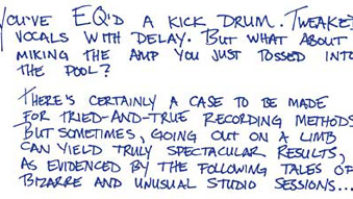
While you are browsing the AES Convention aisles later this month, keep the foundation of your audio facility in mind, and by that I mean the power and ground distribution (P&GD). A humble project studio can be pretty much plug-and-play, but as it gradually morphs into a “facility,” the P&GD infrastructure becomes critical.
This month’s long-distance infrastructure question put me to the test, but before diving into the answer pool, I have a few questions of my own.
Q. “Why is there never enough time to do it right, but always enough time to do it over?”
Actually, this quote is from David Hewitt, and it rings even more true today than when I heard it more than 25 years ago. Then, David was director of the New York Record Plant’s Remote Truck division, not too long before he and Kooster McAllister purchased their respective vehicles. You don’t take a studio on the road without being over-prepared.
Q. “Why is the customer not always right?”
For all of us in the customer service business, this link will make your day.
Our goal may be to give clients what they want, but experience often requires us to speak the truth. This is not always what clients want to hear. You can invest in power and ground infrastructure well into the land of diminishing returns, but without an experienced consultant/contractor guiding the way, random purchases will not ensure that your “silence” is truly golden, especially when the facility spans multiple rooms.
AND NOW, THE REAL QUESTION…
A reader recently asked for assistance in solving power-related noise issues with a side dish of odd digital artifacts. To quickly gain insight into the system, I asked more questions than I answered, and though my consultation fee was more than fair, I’m not sure how much I “helped.” The client was never able to provide me with any wiring documentation (a drawing of the wiring/grounding scheme would have been very helpful), though I did get a picture of the circuit breaker box.
The client’s new studio was a significant upgrade, and as a result he needed to be a bit more particular about power and ground distribution. When the system ground is compromised or overwhelmed, it can also reveal non-power-related noises. That’s why I typically ask for noise samples to differentiate between real problems and technique-induced problems, like when lots of gain and compression are used to create stereotypical heavy-metal guitar tones. And while we are crawling around on the noise floor, grounding issues can aggravate not only power-related noises, but also reveal “the limitations of the equipment.” (Remember when a similar “warning” came on CDs?)
In my control room, a recent noise problem revealed itself while I was experimenting with a phono preamp. The prototype was picking up noise that resembled “some type of data,” the source of which turned out to be my CD player’s display! I’ve been in the same space for 12 years; obviously, the preamp needs to evolve from prototype to market-ready.
ARE YOU WELL-GROUNDED?
With no wiring diagram in hand, I had to start with the tried-and-true: The ideal is a “star” ground system. That’s one simple sentence for man, one complex novel for mankind! Copper rods (roots) are inserted into the earth; the power company does this, but to ensure a long-term clean connection for audio purposes, sometimes multiple rods are used (and must be periodically maintained). From this literal earth connection, a large-diameter cable feeds a bus bar (tree trunk), to which are connected individual but still significant cables (branches) reaching out to each “audio rack,” within which is another bus bar feeding individual ground wires to each piece of gear in the rack (leaves).
The purpose of a dedicated zero-volts distribution system (ZVDS) is to be substantial enough to maintain low impedance between the “central star” and each piece of equipment, no matter how far away. Impedance is the AC version of DC resistance. Because our power distribution system is AC, all of the potential differences—from chassis to chassis—will be some combination of the 60Hz fundamental, plus various related harmonics (buzzes). The ZVDS will be so much more substantial than the safety ground as to literally be the path of least resistance. It is also the most cost-effective.
To the best of my detective abilities, I learned that the client’s only ground-distribution scheme was exclusively through the isolated-ground “hospital-grade” power outlets of the orange variety. This is a good start, but remember that the power outlet ground is for safety, not for low noise. Conventional 120VAC power distribution is unbalanced: The wide blade of the plug is neutral (tied to ground), and only the narrow blade is actually hot. The round pin is safety ground so you won’t get electrocuted while shaving in the shower.
The client had two rack0mounted balanced power boxes. BP uses 120-volt transformers with a center tap tied to ground so that 60 volts appears on each blade—120V from blade to blade. I have never been convinced that BP is “The Big Solution,” primarily because, due to cost, it tends to be used “selectively” rather than system-wide. There are other reasons.
DO YOU NEED BALANCE?
Q. Why, in the opinion of this author, is balanced power not The Big Solution?
The AC power line is supposed to be a pure, undistorted sine wave, but it is far from that. All “appliances” reflect noise and distortion (buzz) back into both the power line and into the safety ground. The noise sources can be from outside the facility, as well as from every appliance in the facility, meaning each outlet will have a unique noise characteristic. Connecting all that gear together can make for wonderful harmony or a cacophony of intermittent random noises—the misnomered “ground loop.”
When balanced power works—as in, with before-and-after tests as proof—I believe its success is attributable to both a real component and a virtual variable.
REAL. What we expect from balanced power distribution: two signals of equal amplitude but opposite polarity reduce potential hum and buzz radiation from power cables into both safety grounds, as well as into nearby audio cables.
VIRTUAL. BP conceals problems caused by some combination of problematic gear and lack of a fully thought-out wiring and grounding plan. Again, this is one sentence that could be a stand-alone article about why some gear must be modified to reduce both internal noise and its reception of external noise. All cabling is an antenna and it can bring noise into susceptible units.
EVERYONE A STAR?
There are two ways to minimize or eliminate power line noise from outside the facility: brute force or via an uninterruptible power supply (UPS). The former is a marriage of the most sophisticated power-line filter/surge protector you can imagine—the good ones, at least. A UPS essentially converts AC to DC (rectifier) and replaces “filter” capacitors with batteries, from which conventional 60Hz AC power can be remanufactured. Larger facilities can justify the expense, so let’s get back to that “star” ground.
Running dedicated ground wires to isolated ground outlets is a step up from conventional commercial wiring, where the conduit typically doubles as the ground wire. It is, however, inadequate for reducing noise because the power/safety ground travels in the same conduit (physically parallel with the power lines), and as a result gets contaminated by noise in the AC power wiring. (This is also why audio and power wiring should never be routed in parallel.) The shorter the parallel distance, the less radiated noise will be picked up. From my own experiments, running the safety ground outside the conduit allows it to remain clean up to the outlet, but that’s not “electrical code,” and you know how pirates stick to the code.
From here I hope you can see that the most effective way to solve noise issues is to run a dedicated zero-volts ground-distribution system. While it may seem to contradict the purpose of the star-grounding systems, it is perfectly acceptable for the dedicated audio ground to be in parallel with the safety ground. (They both should share the same “root.”) The ZVDS is, by design, so much more substantial. It is the path of least resistance: thick-gauge cable that is as close to zero ohms as possible. Any noises—from safety ground and chassis—are short-circuited to the earth ground. That brings us full-circle, which musically is called D.C. al coda.
FINALE
I cannot claim recent facility-wide installation expertise, but I do have loads of troubleshooting experience and have done several modifications and experiments to prove my theories. When in doubt and when referring clients, I seek out people like John Klett, who contributed a distillation of his approach as an online bonus to this article. Thank you, John! And enjoy the show!
Feel free to ask Eddie questions at his MixBlog or visit tangible-technology.com, the virtual homestead.






